In 1988, a summit of health ministers from around the world nominated 1st December as World AIDS Day, a day of action designed to raise public awareness of HIV (human immuno-deficiency virus infection) and AIDS (acquired immune deficiency syndrome). Today is the 26th World AIDS Day.
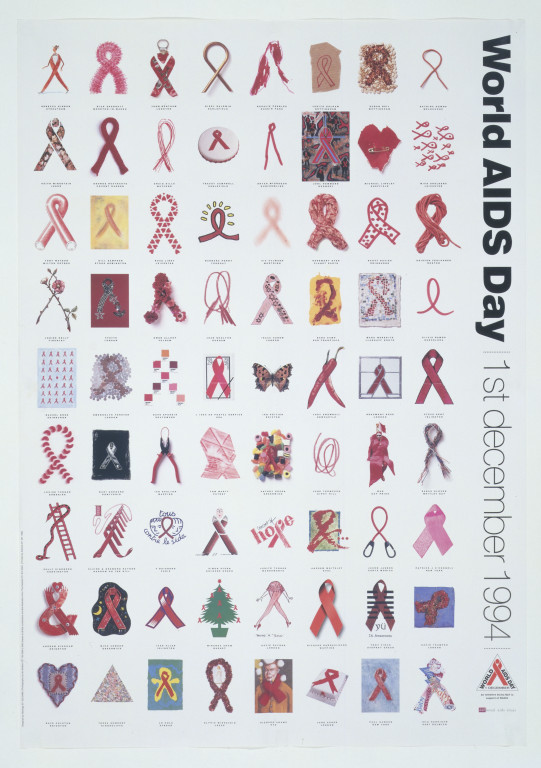
Today, although there is increased access to treatments for HIV and AIDS that can slow the course of the disease, there is still no known cure or vaccine. HIV and AIDS are present in every country on the planet and, despite increased medical knowledge and international efforts to stop it, continues to spread. According to World Health Organization research, at the end of 2013, 35 million people were living with HIV.
The purpose of having a specially designated day were, to quote from the National AIDS Trust:
‘Challenge the DENIAL that leads people to believe they don’t need to protect themselves and their loved ones; the PREJUDICE and DISCRIMINATION against people with HIV; the COMPLACENCY that says ‘AIDS is not my problem’. Support efforts to produce EFFECTIVE and ACCESSIBLE treatments, vaccines and cures.’
The devastation brought about by HIV and AIDS is hard to understate – it is estimated that more than 35 million people have died from the virus, making it one of the most destructive pandemics in history.
It is also a pandemic that brought about the development of a range of striking graphic design and other methods of communication methods, as people fought to communicate important (life-saving) information and challenge misinformation (and developing stigma) from usual media outlets.
Simon Watney, British academic and commentator, noted in 1992 that ‘most people around the world continue to see AIDS not by direct experience, but through sources such as newspapers and televisions. Hence the profound significance of visual imagery, as it largely determines most peoples perceptions of the epidemic.’
Images produced offer a spectrum of: warnings, anger, campaigning, celebration and reassurance. The V&A holds a wide and varied collection of work from around the world that engages with this subject.

In 1996 the Museum exhibited ‘Graphic Responses to AIDS’, a display highlighting the different techniques and media being used by designers in graphic work relating to the HIV/AIDS epidemic. The curator, Shaun Cole, collected more than 100 posters from around the world for the display – these can be seen by appointment through the Prints & Drawings Study Room. As Caroline Roux observed in her review of the exhibition, ‘there is nothing like a taboo or touchy subject to get designers thinking creatively’.
We have already featured Gran Fury’s ‘Kissing Doesn’t Kill’ poster (above) on our blog here, but I wanted to include it again here as a strong example of a work that challenged the attitude and response of the American government to AIDS. I think that the colourful and lively design (co-opting the style of advertising) really ‘sets off’ their obvious underlying anger and frustration at the slow response to deal with epidemic, with its implicit apathy and homophobia.
The couples kissing challenge the then publicly-held misconception that AIDS could be transmitted through social contact, whilst also re-affirming the validity of queer desire in the face of growing institutionally-sanctioned homophobia. The attempt to include a variety of ethnic groups and by showing both men and women, communicates the fact that AIDS does not distinguish between ethnicity, gender or sexuality. Importantly, the text on the poster also challenges ideas concerning the root cause of the crisis – calling attention to the wider social forces at work, beyond the individual.
Many of you in the UK will probably have memories of the hard-hitting television, poster and leaflet campaign that was launched in 1987, when advertising agency, TBWA, was commissioned by the government to create a campaign intended to shock the nation into action.
With the word AIDS hammered into a gravestone, the message was unambiguous in conveying the seriousness and importance of avoiding infection and was unremittingly bleak. Whilst having a dramatic impact on the public awareness (with its tag-line of ‘Don’t Die From Ignorance’), the campaign has been criticised by some for increasing fear and stigma surrounding the subject.

As Danny West describes in his 2011 article ‘Changing Landscapes: A Story About Living With HIV 30 Years On’:
‘The general population’s response to AIDS was one of blame, fear and ignorance this was reflected in the apocalyptic government health campaign in the UK, we were bombarded with dark images of tombstones, graveyards and the Grim Reaper. Society was frantic in its search to find the origins of this new disease and blame the assumed perpetrators. These assumptions lead to a rise in prejudice and the mistreatment and isolation of the gay community.’
Other visual AIDS campaigns opted for a more ‘friendly and encouraging’ approach to motivate people to think carefully about safe sex.
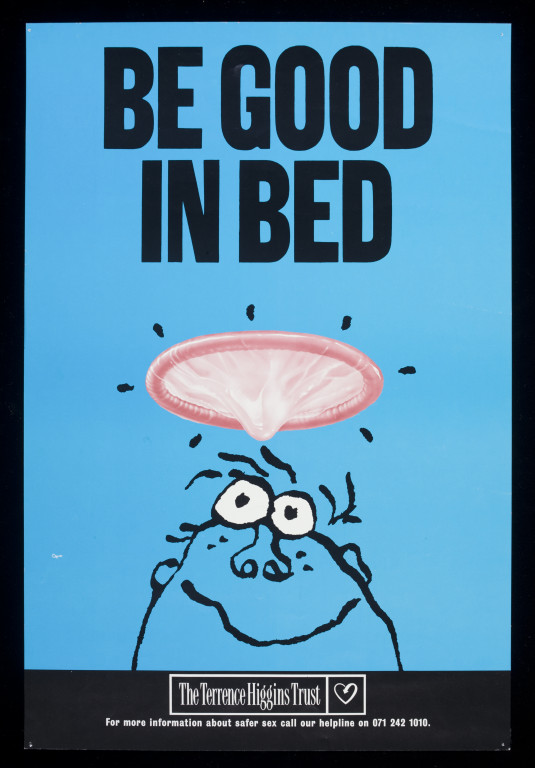
One of the predominant messages to convey became the importance of safe sex and using condoms. Creative and humorous designs saw condoms used to represented a variety of motifs, with the aim of making them appear more familiar and ‘approachable’.
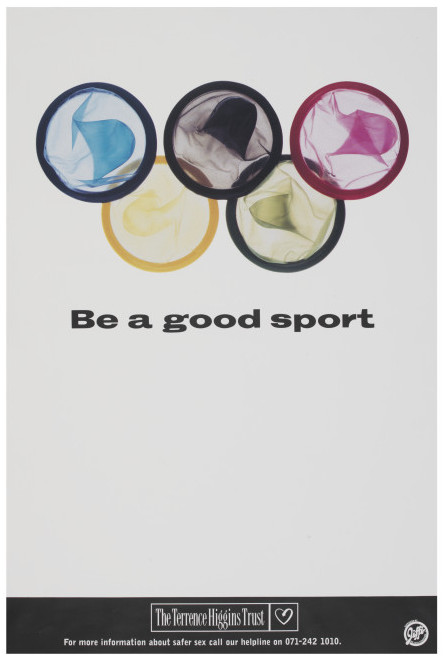
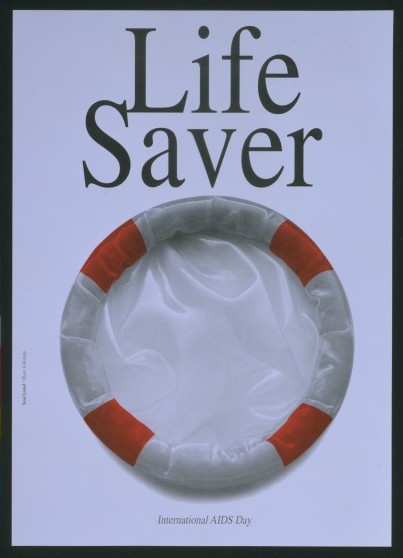
For me personally, the image below is one of the most affecting – AIDS activist David Kirby in the final moments of his life, photographed by Therese Frare in 1990. Yet this is unsettlingly presented to us in the guise of a poster advertising the clothing company Benetton.

V&A Curator Frances Rankine explains that:
‘Benetton has used ‘global issues’ in its posters since the 1980s. It sees campaigns both as a means of advertising and as a focus for discussing the principal social and political issues of our time. Through their universal impact, the campaigns win the attention of the public and stand out from the general mass of media images. This makes for successful advertising. But their publicity attracts both controversy and acclaim, the latter in the form of advertising prizes. In 1992 Benetton began using already published documentary photography. The image of the dying AIDS activist David Kirby caused outrage, despite the fact that the photograph had already been published and Kirby’s family had given their permission. It was felt that the association of such a tragic image with the sale of jumpers was distasteful.’
Below is Andrew Dibb’s direct critical response to this controversial advertisement. Issued by ACT-UP (Aids Coalition to Unleash Power), Dibb’s poster incorporates and questions the ethics of the Benetton advert. The ACT-UP poster states that such an image should be used not in the cause of selling jumpers, but in aid of promoting another kind of ‘pullover’–the condom. The poster proved to be extremely popular and was displayed in schools, colleges, factories etc., in Britain and abroad with language adaption into some countries like Germany, France and Holland.
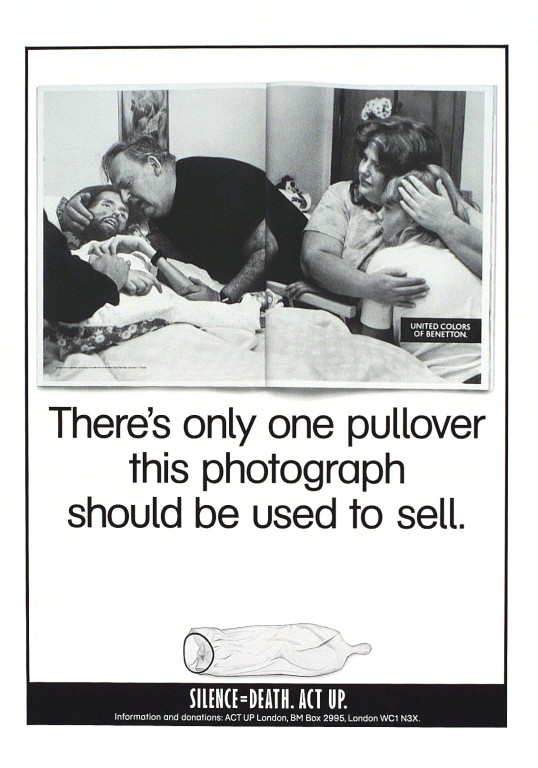
Of course, responses to the AIDS crisis have not all taken the form of posters. The Canadian artists’ collective General Idea designed a wallpaper based on Robert Indiana’s famous ‘Love’ screenprint from 1967, but replaced the letters L.O.V.E. with A.I.D.S. They used this logo to promote AIDS awareness in public places, printing it on carrier bags and posters as well as wallpaper.
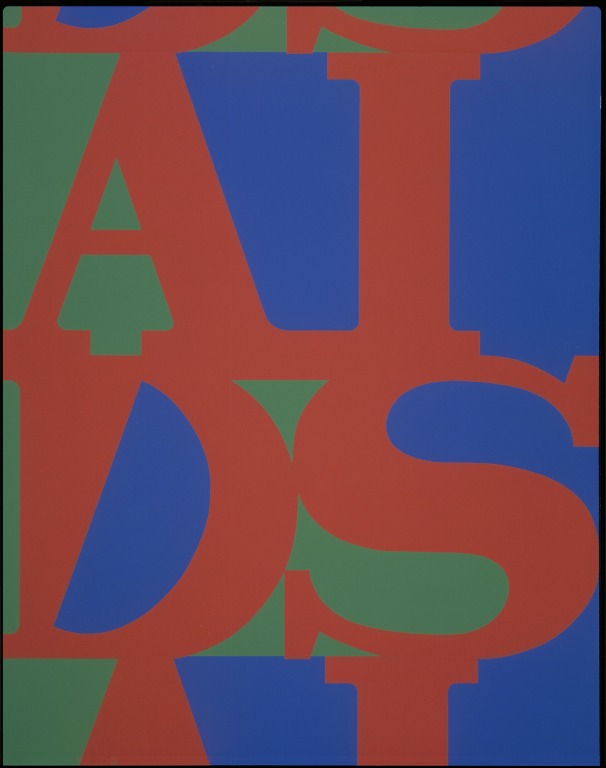
V&A Curator Gill Saunders has described the image as providing an apt metaphor for the action of the HIV virus itself – it is as if the Love motif has been ‘infected’ and has mutated; like the cells invaded by HIV it has kept its form but changed its nature. General Idea intended for the work to have a positive impact by helping to normalise AIDS and remind us that many people live with AIDS, continuing with ordinary routines and domestic lives. This idea is developed by its appearance in Richard Hamilton’s Q.E.D., which itself was an updating of his famous 1956 statement on contemporary society ‘Just what it is that makes today’s homes so different, so appealing?‘

The examples I have featured in this blog post offer just a small glimpse at the variety of art and design works created in response to AIDS. In upcoming posts I will be exploring our collections further and taking a closer look at other design and media techniques, starting with the famous Red Ribbon …

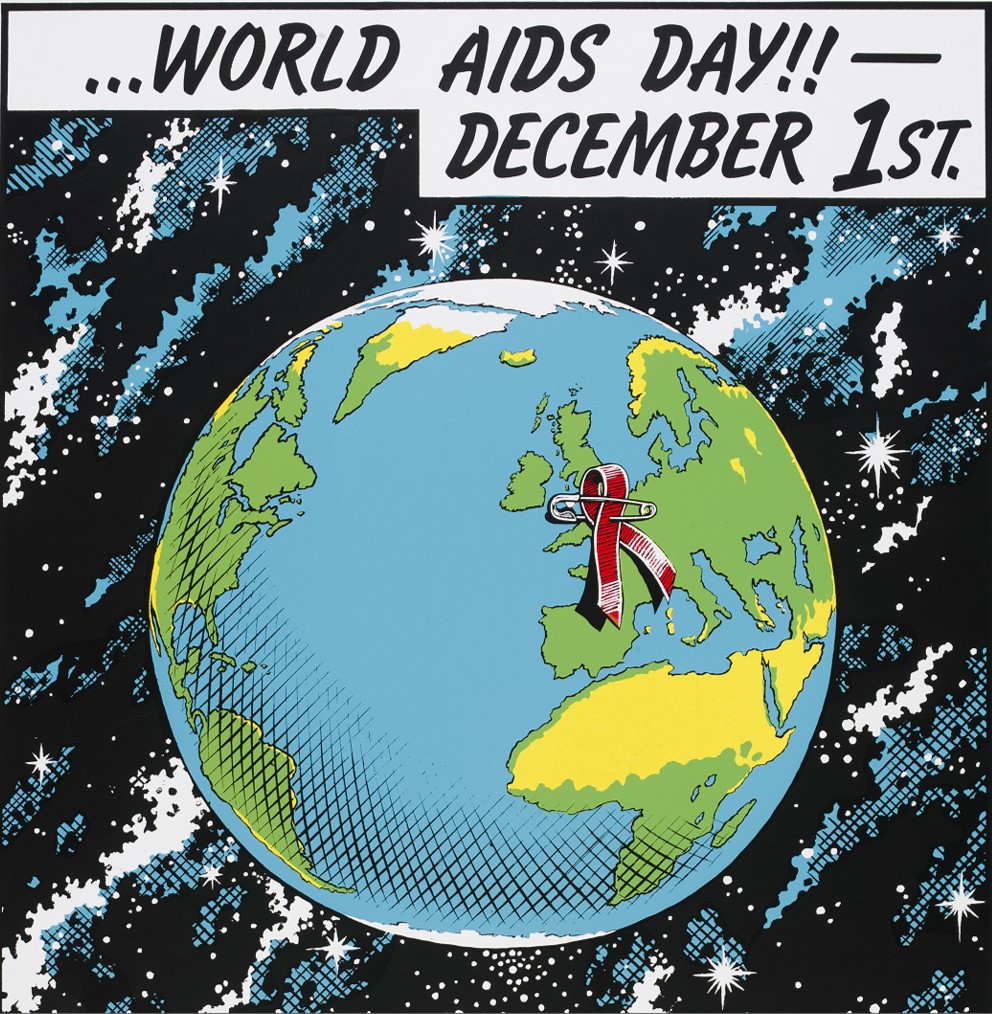

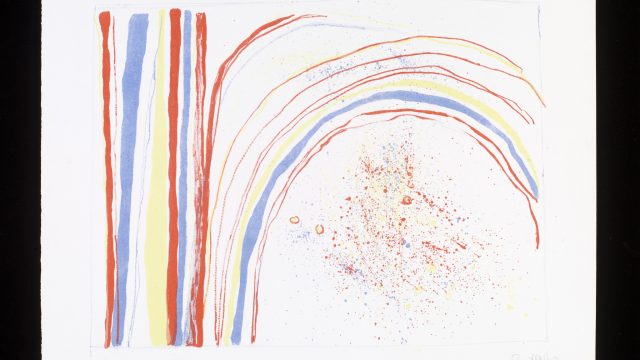

Hi Dawn,
I think we may have already met?
My name is Mehmet, and I am a V&A volunteer and an LGBTQ tour Guide.
Along with Dan Vo and others, we will be presenting to a group of young adults at the V&A on the subject of LGBTQ objects at the V&A, on 28th of this month. My chosen subject are the HIV & AIDS posters and prints. I will focus on the promotions led in the US, i.e. by Gran Fury, but also look into how others countries especially the UK have dealt with the issue, and finish on today’s perspective. I notice that you started a blog, starting with the red ribbon, but I can’t locate any discussions. Would you be able to advise where I can locate information, particularly on the current HIV/AIDS promotion and awareness, or any relevant discussions please?
Best regards,
Mehmet Kavaz